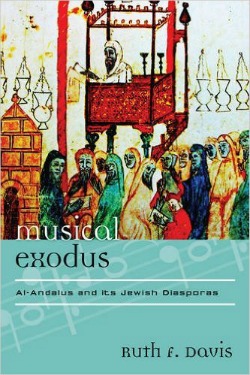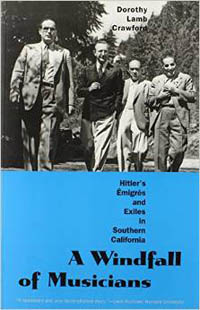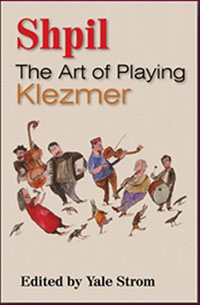Musical Exodus: Al-Andalus and Its Jewish Diasporas, edited by Ruth F. Davis. Lanham, MD: Rowman & Littlefield, 2015. 220 pp.
Reviewed by Jonathan L. Friedmann, Ph.D.
If music is the “Jew” of Jewish studies, as musicologist Edwin Seroussi contends, then Sephardic Jewish music is the “Jew of the Jew” of Jewish studies. Not only is it a marginalized topic, as music generally is, but it also suffers from an Ashkenazi bias, which permeates all of Jewish studies. Ruth F. Davis’s edited anthology, Musical Exodus, strives to fill in the oft-neglected picture. It collects ten research papers on musical subjects related to “Al-Andalus and Its Jewish Diasporas,” the title of a 2008 colloquium of the International Council of Traditional Music held at Cambridge University, which forms the basis of the book.
Following an informative introduction by Davis, Dwight F. Reynolds outlines the complex and multifarious cultural, religious, and musical backgrounds that gave rise to Arabo-Andalusian music (music of medieval Muslim Spain, “al-Andalus” in Arabic). Vanessa Paloma Elbaz examines the subtle integration of “feminine” vernacular songs into male-dominated worship services in Tangier, Morocco. Daniel Jütte looks at the role of Jewish musicians and dance instructors as cultural intermediaries between Jews and Christians in Renaissance Italy. Piergabriele Mancuso describes the cultural makeup of the Sabbatini, a group of southeastern Italian Catholic farmers who claimed to be “children of Israel,” encountered Italian Jewry, formally converted to Judaism, and migrated to Israel en masse in 1950. Philip V. Bohlman describes how images of al-Andalus as a model of religious and cultural tolerance became symbolic for Enlightenment Jews in Europe. John Morgan O’Connell connects the exclusion of indigenous Jewish musicians in early Republican Turkey to the ousting of Eastern (Ottoman) aesthetics, and the assertion of Western culture. Jonathan H. Shannon explores the contradictory silence surrounding Jewish musicians in Syria, and the persistence of “Jewish fingers”—a hand gesture in Syrian musical practice developed by Yacoub Ghazala, a Jewish musician whose memory officials have worked to erased. Tony Langlois discusses Jewish commercial musicians in the port city of Oran, Algeria, who performed an eclectic style known as chanson Oranaise between the 1930s and 50s. Carmel Raz considers the secular revival of piyyutim (liturgical poetry with roots in al-Andalus) in modern-day Israel as a means of bridging secular and sacred and Mizrahi/Sephardic and Ashkenazi. Edwin Seroussi surveys Hebrew Andalusian poetry unique to Jews of Tripoli, Libya and Djerba, Tunisia. Stephen Blum’s afterword urges further investigation into cultural interactions among Jews, Christians, and Muslims in al-Andalus and elsewhere.
Each exploration is richly detailed and defies adequate illustration here. As with any edited volume, some chapters are better presented than others, some fit better within the overarching subject, and some are of more inherent interest to the reader. (These observations are, of course, subjective.) Nevertheless, the book’s expansive timeframe, dispersed geographies, and widely varied musical traditions paint a composite portrait—by way of case study—of a vibrant and multi-layered area of Jewish music, history, and culture.
From this sundry material emerges four recurring themes of special interest to this reviewer. First is the pervasive myth of Jewish life in al-Andalus as a “golden age.” As with any romanticized period, medieval Spain was not quite as glorious as the romanticists claim. Both Davis and Bohlman trace the myth to Enlightenment Jews in eighteenth- and nineteenth-century Europe, who saw al-Andalus as a paradigm of ideals they cherished: equality, religious tolerance, and cross-cultural interaction. Davis writes: “Pitting an idealized Islamic tradition of tolerance against the grim realities of European anti-Semitism, they constructed a ‘historical myth’ of an interfaith utopia under medieval Islamic rule, which they presented as a challenge to Christian Europe and as a strategy to improve their own position” (p. xv). The myth was later taken up by Arab academics and journalists, who blamed Zionism for turning Arabs against Jews. Jewish historians countered with earlier evidence of intolerance and persecution in Arab lands and the founding books of Islam. Mizrahi Jews who immigrated to Israel from Muslim countries used the “counter-myth” of persecution to align themselves with downtrodden Ashkenazi Jews, and “claim an equal share of the Zionist dream” (p. xvi). Naturally, each myth and counter-myth exhibits degrees of cherry-picking for political purposes.
A second theme is oral transmission. According to Reynolds, “Because musical notation was not in use in Muslim Spain, we possess a wide variety of historical sources about medieval Andalusian music but not the music itself….On the other hand, the large number of living musical traditions that claim some sort of descent from the music of medieval Muslim Spain does allow us—with great care and very judiciously—to navigate at times back and forth between medieval historical documents and modern living traditions and to come to an approximate understanding of the basic structures of medieval Arabo-Andalusian music” (pp. 3-4). This helps to explain both the diversity and continuity within and between various idioms expressive of an “Arab style.” With reliance on generational transfer rather than written notation, these traditions could develop and flourish in a variety of directions without losing a fundamental link to the past.
The third area is the role of poetry. In the classical conception, Arab music was not considered an independent art form, but a vehicle for sung poetry. Thus, melodic construction was largely dictated by the rhythms, meters, and forms of Arabic poetry (essentially a form of logogeneic, or word-born, music). Because of this more or less stable linguistic foundation, the “Arab style” could accept expanding influences from Byzantine, Persian, African, and other sources without losing its aesthetic signatures.
Fourth, and most central, is hybridity. Again quoting Reynolds: “Over a period of nine centuries, from 711 to 1610, there is evidence of professional musicians from a variety of different ethnic, religious, and regional origins performing diverse musical traditions before patrons and audiences of diverse backgrounds. There is also good evidence for understanding the music itself (and not just the music makers) as a very cosmopolitan tradition that incorporated influences from multiple sources and developed innovative new forms by combining and hybridizing traditions” (pp. 21-22). Such hybridity remained a feature of the Sephardic diaspora. For example, Jewish performers of chanson Oranaise, mentioned above, combined medieval Andalusian repertoire and French chanson, a popular genre of music halls and cabarets. Beyond music, hybridity is a characteristic of Sephardic languages, such as the Moroccan Judeo-Spanish vernacular of Haketía, which combines Spanish, Moroccan Arabic, and Hebrew, as well as performance contexts, such as the piyyut revival in Israel, which mixes secular and sacred, East and West.
These themes and the chapters that elucidate them remind us not only of the substantial musical contributions of al-Andalus and its Jewish diasporas, but also of the complex and nearly indefinable nature of Jewish music. More broadly, they support the case for answering questions of “Jewishness”—musical and otherwise—in the plural: Jewish identities, Jewish traditions, Jewish styles, Jewish diasporas, Judaisms. As Ruth Rubin observed decades ago, the music of the Jews is “as diverse and variegated as the Jews themselves” (A Treasury of Jewish Folksong, 1950).
Visit Jonathan’s website to keep up on his latest endeavors, browse his book and article archives, and listen to sample compositions.





